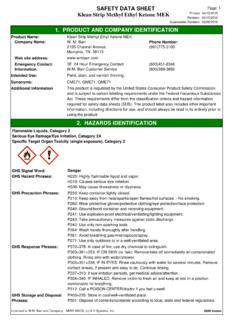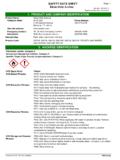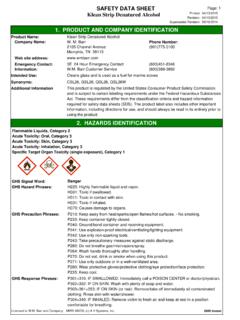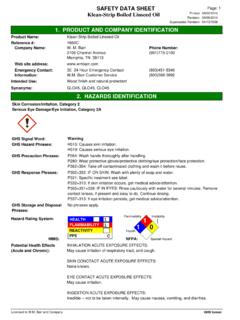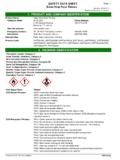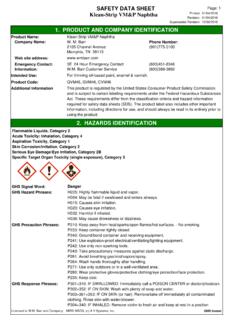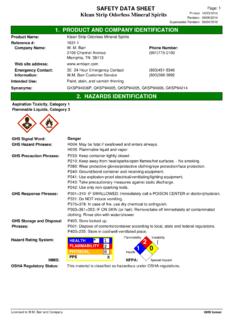Transcription of SAFETY DATA SHEET Page: 1 Klean Strip Lacquer Thinner ...
1 SAFETY DATA SHEET Page: 1. Klean Strip Lacquer Thinner Revision: 05/24/2017. Supersedes Revision: 04/03/2017. 1. PRODUCT AND COMPANY IDENTIFICATION. Product Name: Klean Strip Lacquer Thinner Company Name: W. M. Barr Phone Number: 2105 Channel Avenue (901)775-0100. Memphis, TN 38113. Web site address: Emergency Contact: 3E 24 Hour Emergency Contact (800)451-8346. Information: Barr Customer Service (800)398-3892. Intended Use: Paint, stain, and varnish thinning. Product Code: GML170, QML170, CML170, DML170, GML170P, PA12782, QML170W, GML170W, GML170 HDWS, PML1701. 2. HAZARDS IDENTIFICATION. Flammable Liquids, Category 2. Acute Toxicity: Oral, Category 3. Acute Toxicity: Skin, Category 3. Acute Toxicity: Inhalation, Category 3. Serious Eye Damage/Eye Irritation, Category 2. Toxic To Reproduction, Category 2. Specific Target Organ Toxicity (single exposure), Category 1. Specific Target Organ Toxicity (repeated exposure), Category 2. Aspiration Toxicity, Category 1. GHS Signal Word: Danger GHS Hazard Phrases: H225: Highly flammable liquid and vapor.
2 H301: Toxic if swallowed. H304: May be fatal if swallowed and enters airways. H311: Toxic in contact with skin. H319: Causes serious eye irritation. H331: Toxic if inhaled. H361: Suspected of damaging fertility or the unborn child. H370: Causes damage to organs. H373: May cause damage to organs through prolonged or repeated exposure. GHS Precaution Phrases: P201: Obtain special instructions before use. P202: Do not handle until all SAFETY precautions have been read and understood. P210: Keep away from heat/sparks/open flames/hot surfaces. - No smoking. P233: Keep container tightly closed. P240: Ground/bond container and receiving equipment. P241: Use explosion-proof electrical/ventilating/lighting equipment. P242: Use only non-sparking tools. P243: Take precautionary measures against static discharge. P260: Do not breathe gas/mist/vapors/spray. P264: Wash hands thoroughly after handling. P270: Do not eat, drink or smoke when using this product. P271: Use only outdoors or in a well-ventilated area.
3 P280: Wear protective gloves/protective clothing/eye protection/face protection. P281: Use personal protective equipment as required. P235: Keep cool. Licensed to Barr and Company GHS format SAFETY DATA SHEET Page: 2. Klean Strip Lacquer Thinner Revision: 05/24/2017. Supersedes Revision: 04/03/2017. GHS Response Phrases: P301+310: IF SWALLOWED: Immediately P311: Call a POISON CENTER or doctor/physician. P302+352: IF ON SKIN: Wash with plenty of soap and water. P303+361+353: IF ON SKIN (or hair): P361: Remove/Take off immediately all contaminated clothing. Rinse skin with water/shower. P304+340: IF INHALED: Remove victim to fresh air and keep at rest in a position comfortable for breathing. P305+351+338: IF IN EYES: Rinse cautiously with water for several minutes. Remove contact lenses, if present and easy to do. Continue rinsing. P307+311: IF exposed: P311: Call a POISON CENTER or doctor/physician. P308+313: IF exposed or concerned: Get medical attention/advice. P314: Get medical attention/advice if you feel unwell.
4 P321: Specific treatment see label. P330: Rinse mouth. P331: Do NOT induce vomiting. P337+313: If eye irritation persists, get medical advice/attention. P363: Wash contaminated clothing before reuse. P370+378: In case of fire, use dry chemical powder to extinguish. GHS Storage and Disposal P403+233: Store container tightly closed in well-ventilated place. Phrases: P405: Store locked up. P501: Dispose of contents/container according to local, state and federal regulations. Flammability Instability Hazard Rating System: HEALTH * 2 3. FLAMMABILITY 3. PHYSICAL 0 Health 2 0. PPE X. HMIS: NFPA: Special Hazard OSHA Regulatory Status: This material is classified as hazardous under OSHA regulations. Potential Health Effects Inhalation Acute Exposure Effects: (Acute and Chronic): Vapor harmful. May cause dizziness; headache; watering of eyes; irritation of respiratory tract; weakness; drowsiness; nausea; numbness in fingers, arms and legs; depression of central nervous system; loss of appetite; fatigue; hallucinations; light headedness; visual disturbances; giddiness and intoxication; sleepiness; cough and dyspnea; cold, clammy extremities; diarrhea; vomiting; dilation of pupils; spotted vision.
5 Severe overexposure may cause convulsions; unconsciousness; coma; and death. Intentional misuse of this product by deliberately concentrating and inhaling can be harmful or fatal. Skin Contact Acute Exposure Effects: May be absorbed through the skin. May cause irritation; numbness in the fingers and arms; drying of skin; and dermatitis. May cause increased severity of symptoms listed under inhalation. Eye Contact Acute Exposure Effects: This material is an eye irritant. May cause irritation; burns; conjunctivitis of eyes; and corneal ulcerations of the eye. Vapors may irritate eyes. Ingestion Acute Exposure Effects: Poison. Cannot be made non-poisonous. May be fatal or cause blindness. May cause dizziness; headache; nausea; vomiting; burning sensation in mouth, throat, and stomach; loss of coordination; depression of the central nervous system; narcosis;. stupor; gastrointestinal irritation; liver, kidney, and heart damage; diarrhea; loss of appetite; coma and death.
6 May produce symptoms listed under inhalation. Licensed to Barr and Company GHS format SAFETY DATA SHEET Page: 3. Klean Strip Lacquer Thinner Revision: 05/24/2017. Supersedes Revision: 04/03/2017. Chronic Exposure Effects: Reports have associated repeated and prolonged overexposure to solvents with neurological and other physiological damage. Prolonged or repeated contact may cause dermatitis. Prolonged skin contact may result in absorption of a harmful amount of this material. May cause conjunctivitis; gastric disturbances; insomnia; dizziness; headache;. weakness; fatigue; nausea; heart palpitations; skin irritation; numbness in hands and feet; permanent central nervous system changes; some loss of memory; pancreatic damage; giddiness; visual impairment or blindness; kidney or liver damage; and death. May cause symptoms listed under inhalation. Target Organs: Central Nervous System, Liver, Kidney, Heart, Stomach, Respiratory System Primary Routes of Entry: Inhalation, Ingestion, Skin Absorption Medical Conditions Generally Diseases of the skin, eyes, liver, kidneys, central nervous system and respiratory Aggravated By Exposure: system.
7 3. COMPOSITION/INFORMATION ON INGREDIENTS. CAS # Hazardous Components (Chemical Name) Concentration 67-56-1 Methanol {Methyl alcohol; Carbinol; Wood %. alcohol}. 67-64-1 Acetone {2-Propanone} %. NA Petroleum Hydrocarbon Mixture (Alkanes and %. Cycloalkanes). 141-78-6 Acetic acid, ethyl ester {Ethyl acetate} < %. 108-88-3 Toluene {Benzene, Methyl-; Toluol} < %. 111-76-2 Ethanol, 2-Butoxy- {Ethylene glycol n-butyl ether, < %. (a glycol ether)}. Additional Chemical Specific percentage of composition is being withheld as a trade secret. Information 4. FIRST AID MEASURES. Emergency and First Aid Skin: Procedures: Immediately begin washing the skin thoroughly with large amounts of water and mild soap, if available, while removing contaminated clothing. Seek medical attention if irritation persists. Eyes: Immediately begin to flush eyes with water, remove any contact lens. Continue to flush the eyes for at least 15 minutes, then seek immediate medical attention. Inhalation: Remove to fresh air.
8 If not breathing, give artificial respiration. If breathing is difficult, give oxygen. Get immediate medical attention. Ingestion: If swallowed, do not induce vomiting. Seek immediate medical attention. Call a physician, hospital emergency room, or poison control center immediately. Never give anything by mouth to an unconscious person. In Case of Inhalation: IF INHALED: Remove victim to fresh air and keep at rest in a position comfortable for breathing. Licensed to Barr and Company GHS format SAFETY DATA SHEET Page: 4. Klean Strip Lacquer Thinner Revision: 05/24/2017. Supersedes Revision: 04/03/2017. In Case of Skin Contact: IF ON SKIN (or hair): Remove/take off immediately all contaminated clothing. Rinse skin with water/shower. In Case of Eye Contact: IF IN EYES: Rinse cautiously with water for several minutes. Remove contact lenses, if present and easy to do. Continue rinsing. In Case of Ingestion: If swallowed, do NOT induce vomiting. Call a physician, hospital emergency room, or poison control center immediately.
9 Never give anything by mouth to an unconscious person. Signs and Symptoms Of See Potential Health Effects. Exposure: Note to Physician: Poison. This product contains methanol. Methanol is metabolized to formaldehyde and formic acid. These metabolites may cause metabolic acidosis, visual disturbances and blindness. Since metabolism is required for these toxic symptoms, their onset may be delayed from 6 to 30 hours following ingestion. Ethanol competes for the same metabolic pathway and has been used as an antidote. Methanol is effectively removed by hemodialysis. Call your local poison control center for further information. 5. FIRE FIGHTING MEASURES. NFPA Class IB. Flash Pt: < F Method Used: Setaflash Closed Cup (Rapid Setaflash). Explosive Limits: LEL: 1 UEL: 7. Autoignition Pt: No data. Suitable Extinguishing Media:Use carbon dioxide, dry powder, or foam. Unsuitable Extinguishing Do not use a solid water stream, as this may spread the fire. Media: Fire Fighting Instructions: Self-contained respiratory protection should be provided for fire fighters fighting fires in buildings or confined areas.
10 Storage containers exposed to fire should be kept cool with water spray to prevent pressure build-up. Stay away from heads of containers that have been exposed to intense heat or flame. Flammable Properties and No data available. Hazards: 6. ACCIDENTAL RELEASE MEASURES. Steps To Be Taken In Case Vapors may cause flash fire or ignite explosively. Material Is Released Or Spilled: Clean up: Keep unnecessary people away; isolate hazard area and deny entry. Stay upwind, out of low areas, and ventilate closed spaces before entering. Shut off ignition sources; keep flares, smoking or flames out of hazard area. Use non-sparking tools. Use proper bonding and grounding methods for all equipment and processes. Keep out of waterways and bodies of water. Be cautious of vapors collecting in small enclosed spaces, sewers, low lying areas, confined spaces, etc. Small spills: Take up with sand, earth or other noncombustible absorbent material and place in a plastic container where applicable.
